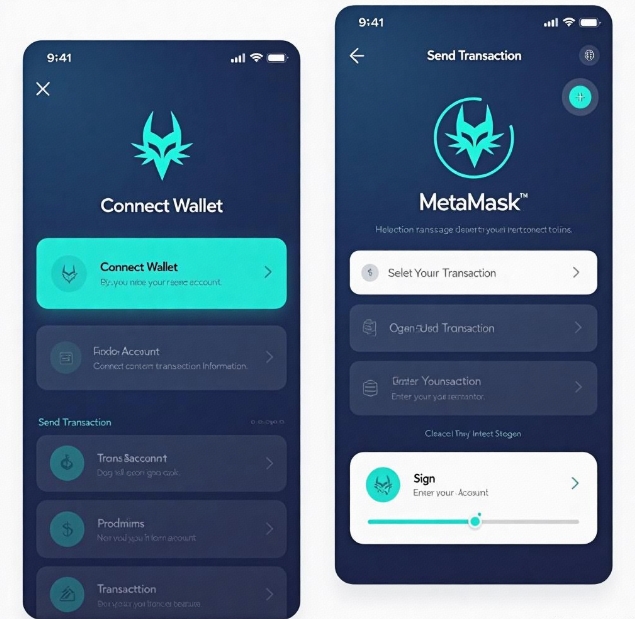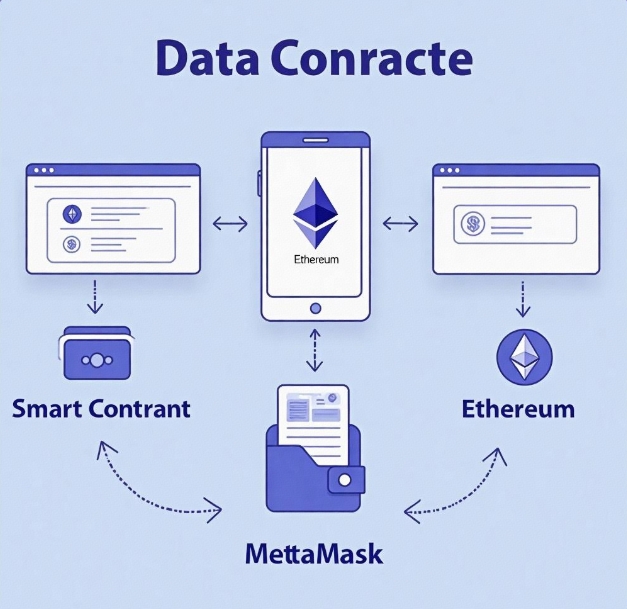How to Integrate DApp with MetaMask? Wallet Connection and User Interaction Tutorial
- latest articles
- 1.DApp Development & Customization: Merging Diverse Market Needs with User Experience 2.Analysis of the Core Technical System in DApp Project Development 3.How to achieve cross-chain interoperability in Web3 projects? 4.How does the tokenization of points reconstruct the e-commerce ecosystem? 5.How to Set and Track Data Metrics for a Points Mall? 6.What is DApp Development? Core Concepts and Technical Analysis 7.Inventory of commonly used Web3 development tools and usage tips 8.Development of a Distribution System Integrated with Social E-commerce 9.Six Key Steps for Businesses to Build a Points Mall System 10.What is DApp Development? A Comprehensive Guide from Concept to Implementation
- Popular Articles
- 1.Future Trends and Technology Predictions for APP Development in 2025 2.Analysis of the DeFi Ecosystem: How Developers Can Participate in Decentralized Finance Innovation 3.From Zero to One: How PI Mall Revolutionizes the Traditional E-commerce Model 4.DAPP Development | Best Practices for Professional Customization and Rapid Launch 5.Recommended by the Web3 developer community: the most noteworthy forums and resources 6.From Cloud Computing to Computing Power Leasing: Building a Flexible and Scalable Computing Resource Platform 7.How to Develop a Successful Douyin Mini Program: Technical Architecture and Best Practices 8.Shared Bike System APP: The Convenient Choice in the Era of Smart Travel 9.How to Create a Successful Dating App: From Needs Analysis to User Experience Design 10.From Design to Development: The Complete Process of Bringing an APP Idea to Life
With the continuous development of blockchain technology, decentralized applications (DApps) have become one of the significant innovations. DApps (Decentralized Applications) feature decentralization, transparency, and security, attracting the attention of numerous developers and users. MetaMask, as one of the most popular Ethereum wallets today, not only supports the storage and transfer of ETH and ERC-20 tokens but also enables seamless connection and interaction with DApps. This article will detail how to integrate DApps with MetaMask, helping developers easily achieve wallet connection and user interaction.
1. What is MetaMask?
MetaMask is an Ethereum wallet that allows users to manage their Ethereum accounts and private keys, and interact with decentralized applications (DApps) through browser extensions or mobile apps. MetaMask supports various browsers (such as Chrome, Firefox) and mobile devices. As an essential component of the Ethereum ecosystem, MetaMask not only provides users with convenient asset management tools but also offers developers functionalities to interact with the blockchain.
The main features of MetaMask include:
User Private Key Management: MetaMask gives users control over their private keys, ensuring the security of their funds.
Interaction with DApps: Users can interact with DApps through MetaMask to manage assets on Ethereum, sign transactions, and perform other operations.
Multi-Chain Support: MetaMask not only supports the Ethereum mainnet but also other EVM-compatible chains like BSC and Polygon.
2. Introduction to DApps
DApps, or decentralized applications, are applications that run on the blockchain. Unlike traditional applications, DApps do not rely on a single server or central database but execute through smart contracts on the blockchain. This design gives DApps decentralized characteristics, offering high security and transparency.
The core components of DApps include:
Smart Contracts: Used to execute application logic on the blockchain, managing assets, data storage, and other functions.
Frontend Application: Typically a web interface through which users interact with the DApp via a browser.
Blockchain: Stores DApp data and smart contract execution results, ensuring decentralization and transparency.
3. How to Integrate MetaMask into a DApp?
Integrating MetaMask into a DApp typically involves two main parts: wallet connection and user interaction. The following sections will detail how to implement these two parts.
3.1 Wallet Connection
To enable interaction between the DApp and MetaMask, a wallet connection must first be established. Interaction between the DApp and MetaMask primarily occurs through the window.ethereum object.
Step 1: Check if MetaMask is Installed
Before integrating MetaMask, it is necessary to check if the user has MetaMask installed. This can be done by checking for the window.ethereum object:
if (typeof window.ethereum !== 'undefined') {
console.log('MetaMask is installed!');
} else {
console.log('Please install MetaMask!');
}
If MetaMask is not installed, developers can guide users to install the MetaMask extension or display an installation prompt on the interface.
Step 2: Request User Account Connection
Once the MetaMask extension is successfully installed, users need to connect their MetaMask wallet through the DApp. Use the ethereum.request method to request user authorization to connect their Ethereum account.
async function connectMetaMask() {
try {
const accounts = await window.ethereum.request({ method: 'eth_requestAccounts' });
console.log('Connected account:', accounts[0]);
} catch (error) {
console.error('User denied account access', error);
}
}
When the eth_requestAccounts method is called, MetaMask will display a prompt asking the user to authorize the DApp to access their Ethereum account. After the user agrees, the accounts array will contain the currently connected account address.
3.2 Get Account Information
After a successful connection, the user's currently selected account address can be obtained via window.ethereum.selectedAddress. If the user switches accounts, updates can also be captured by listening to the accountsChanged event.
window.ethereum.on('accountsChanged', (accounts) => {
console.log('Account changed:', accounts[0]);
});
With the above code, you can capture real-time changes in the user's account, ensuring the DApp always interacts with the currently selected account.
3.3 Monitor Network Changes
In addition to account changes, MetaMask also allows DApps to monitor network changes. For example, when a user switches from the mainnet to a testnet, the DApp can respond promptly and make adjustments.
window.ethereum.on('chainChanged', (chainId) => { console.log('Network changed:', chainId);
window.location.reload(); // Force refresh the page to ensure the network switch takes effect});
4. Interacting with Users
Once the wallet is successfully connected, the DApp can perform a series of interactive operations with MetaMask, such as sending transactions, signing messages, etc. Next, we will introduce several common interaction methods.
4.1 Sending Transactions
Through MetaMask, users can send ETH or other tokens to other Ethereum addresses. Sending transactions requires using the eth_sendTransaction method.
async function sendTransaction() {
const transactionParameters = {
to: '0xReceiverAddress', // Recipient address
from: window.ethereum.selectedAddress, // Current account
value: '0xAmountInWei', // Amount of ETH to send (in Wei)
gasPrice: '0xGasPrice', // Gas price
gas: '0xGasLimit', // Gas limit
};
try {
const txHash = await window.ethereum.request({
method: 'eth_sendTransaction',
params: [transactionParameters],
});
console.log('Transaction hash:', txHash);
} catch (error) {
console.error('Transaction failed:', error);
}
}
With the above code, the DApp can prompt the user with a transaction confirmation dialog in MetaMask; once confirmed, the transaction will be sent to the blockchain.
4.2 Signing Messages
DApps can also request users to sign messages. Message signing is primarily used for scenarios like identity verification and authorization. Message signing is implemented via the personal_sign method.
async function signMessage() {
const message = 'Sign this message to authenticate';
const from = window.ethereum.selectedAddress;
try {
const signature = await window.ethereum.request({
method: 'personal_sign',
params: [message, from],
});
console.log('Signed message:', signature);
} catch (error) {
console.error('Message signing failed:', error);
}
}
By signing messages, the DApp can verify the user's identity, ensuring the security of operations.
5. Precautions and Best Practices
When interacting with MetaMask, developers should pay attention to the following points:
User Authorization: Ensure the DApp obtains sufficient authorization when accessing the user's wallet to avoid infringing on user privacy.
Error Handling: Try to handle situations like user refusal of authorization and network errors to improve user experience.
Chain ID Check: When sending transactions, ensure the current network matches the target network to avoid transaction failures due to network inconsistencies.
Gas Fees: DApps should consider calculating and displaying gas fees to prevent users from abandoning operations due to unclear transaction costs.
6. Summary
Integrating DApps with MetaMask provides a convenient user interaction experience for decentralized applications. Whether it's wallet connection, account management, transaction signing, or information verification, MetaMask offers rich API support. By following the correct implementation process and best practices, developers can ensure smooth interaction between the DApp and MetaMask, offering users a more secure and convenient decentralized experience.
We hope this article helps developers better understand how to integrate MetaMask and interact with DApps. If you encounter issues during development, remember to consult MetaMask's official documentation and join relevant developer communities to share experiences with other developers.
-

DApp Development & Customization: Merging Diverse Market Needs with User Experience
As blockchain technology matures and becomes more widespread, decentralized appl···
-

Analysis of the Core Technical System in DApp Project Development
With the rapid development of blockchain technology, decentralized applications ···
-

What is DApp Development? Core Concepts and Technical Analysis
With the rapid development of blockchain technology, decentralized applications ···

 Blockchain
Blockchain











